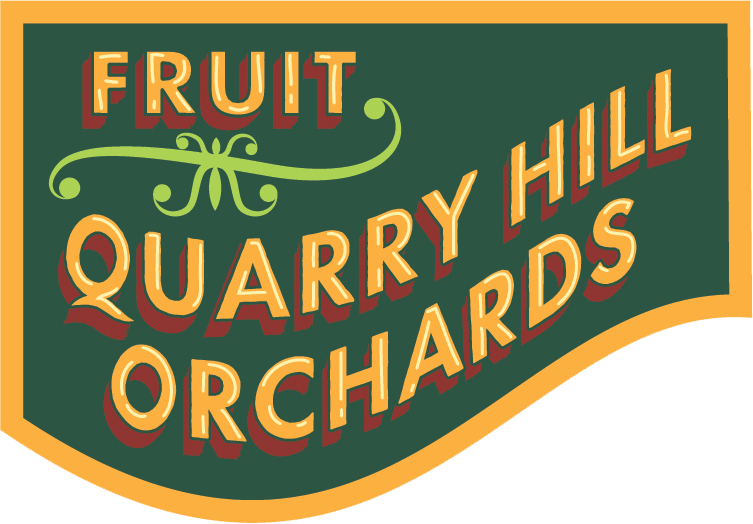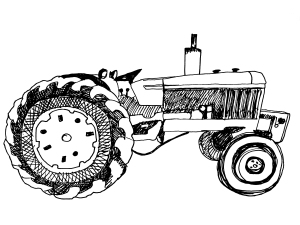 BROOKE’S BULLETIN
BROOKE’S BULLETIN
July 2019
This cherry season’s biggest fan: Jennifer Thornton, Owner & Educator, Buttercream & Olive Oil shares her anecdotal recipe and techniques for canning cherries.
Living in France for five years, one of my cherished memories is afternoons spent in Lolo’s cherry tree. Lolo is currently 95 years old and afternoons at his ancient Roman quarry farm were always spectacular. During cherry season, after a lengthy lunch, I would climb up into the stately cherry tree and eat as many cherries as I could until I couldn’t eat anymore. Whether they were the most delicious cherries in the world or not is debatable, but the memory of the Provençal sun and cigales singing, the company of best friends and so much delicious food, I cannot remember them being anything but the best.
That is until this summer as we ventured out to Quarry Hill for a Sunday afternoon of cherry picking. The trees were dripping with giant bunches of cherries. I will admit, I am a thoroughly devout sour cherry fan. I only stopped at 15 pounds because it was closing time. The sweet cherries were overwhelming plentiful and awe-inspiring and 20 lbs were picked easily picked in about an hour and half. These cherries are nothing short of exquisite. If you are new to picking cherries, remember the stems will keep the longer, so if you do not plan to eat or use them soon, pick with the stem. Picking your own fruit is one of life’s most gratifying delights. For me the only problem is I never know when to stop. When the fruit is plentiful and beautiful, I always think what I pick is just never enough. Of course, this really is not a bad thing and being staunchly locavore, the only cherries I eat all year will be local. This is why I freeze or can 90% of what I pick. Cherries are particularly fun to preserve through canning because no sugar is needed, in following with the USDA guidelines. This is for both sweet and sour cherries.
Canning Whole Cherries in Lemon Juice
What you will need:
- 15 pounds of sweet or sour cherries, whole and pitted (prefererably from Quarry Hill Orchards!)
- Filtered water
- 4 Organic Lemons
- About 6 one-quart mason jars, sterilized
Prepare all the tools necessary for canning. Clean whole cherries well by triple washing in a vinegar bath. Clean your whole lemons the same way.
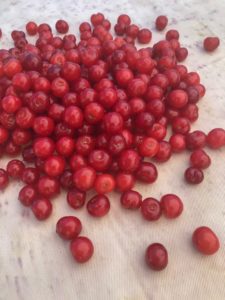
Pit the cherries, leaving them whole. You can get a handy little tool, but the rounded end of a bobby pin works great on the smaller fragile sour cherries and a small copper pipe works great on the plump sweet cherries.
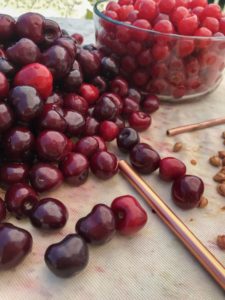 While preparing the cherries, place mason jars and lids in the dishwasher and run without soap. Fill a large canning pot with water and set on the stove. In a large saucepan, add approximately 4 quarts of water to the halved lemons. Bring this to a boil.
While preparing the cherries, place mason jars and lids in the dishwasher and run without soap. Fill a large canning pot with water and set on the stove. In a large saucepan, add approximately 4 quarts of water to the halved lemons. Bring this to a boil.
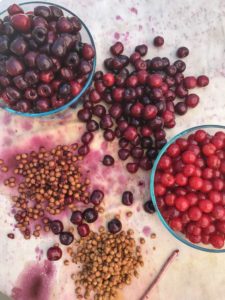
For raw-packing, meaning the cherries are not heated before placing in the jars, add 1/2 cup hot lemon water to each jar. Fill hot jars with pitted whole cherries, shaking down gently as you fill. Add more hot liquid, leaving 1/2-inch headspace. Remove air bubbles and adjust headspace if needed. Wipe rims of jars with a dampened clean paper towel. Adjust lids and process in the boiling water bath, assuring that the water sufficiently covers the lids. Boil for 25 minutes.
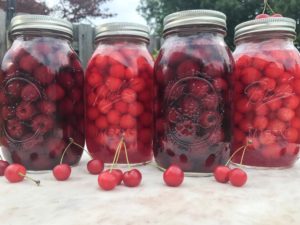
*Sweet cherries or sour cherries can be canned separately or mixed together as well.
If this seems overwhelming, come can with me! This summer, I am offering two basic canning courses, because honestly the first time can be overwhelming. Canning is so rewarding and quite easy, but the process can be lengthy. I can about 100 or more quarts throughout the summer and as much as I love it, I always think about how it used to be done with families, friends and neighbors coming together to peel and chop and fill and boil…all in the good company of others. My canning class will hopefully bring a little of that community and have you feeling confident to go home and preserve summers bounty on your own. My July and August Canning Classes will be held in historic Medina Square. For more info, visit buttercreamandoliveoil.com
